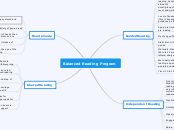Balanced Reading Program
Guided Reading
Bridge between shared reading and independent reading, handing more responsibility over to the students
Small group of students that are around the same level and working on the same reading strategies
Level of books: just above independent reading level (this is because they have teacher support and guidance as they read)
Apply previously taught strategies to the texts they are reading
Meets specific needs for individual students
Great time to assess students and their individual needs
Materials: Many copies of levelled books, semi-circle table to sit around teacher, magnetic board and letters, chart paper, sentence strips
Word walls and posters can be effective for guided reading and knowing the strategies to use if the posters and wall words are used appropriately
Time: 10 to 15 minutes
Independent Reading
Final stage of gradual release of responsibility. Students should be able to engage in independent reading activities with no support from the teacher (or very little support)
Includes: reading to self, reading with a partner, readers theater, literature circles, and other activities
Practice and consolidate learned reading strategies
Literacy rich environment
Classroom library
Engaging activities and centers that students work in
Before, During and After reading activities
Read alouds
Used to demonstrate or model cueing systems and reading strategies for students
Variety of genres read
Level of books: generally higher level of books than students are reading that lead to rich discussions
Teacher led, first step in gradual release of responsibility
Time: 10 to 30 minutes depending on the age of the children and the discussions occurring
Shared Reading
Big books, chart paper, projector or SmartBoard to allow students to engage in the book and follow along
Objects relating to the story, puppets, sticky notes, tape are materials that are helpful for shared reading
Teacher led with student interaction, second step of gradual release of responsibility
Level of books: challenging enough to encourage problem solving with teacher support while still engaging the students
Shared reading should take place everyday for Emergent and Early readers, 2 to 3 times per week for Fluent Readers
Helps to build on students knowledge and use more complex reading strategies with teacher support
